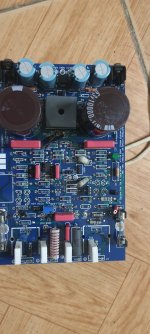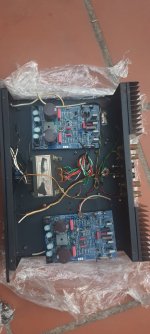Turned off the power amp first and then the preampAnd in what sequenced did you switch the gear off "at noon" (when it was still operational)?
Yes absolutely. I have been doing a decent amount of DIY in the past. But as you said, I will try to send it to a professional and see if it can be resolved earlierI have a question. If the problem were to be identified and required soldering, would you be able to do this? Do you have knowledge of circuitry and experience? This is not 'replace the fuse and all is well'. Something bad happened and it will be an involved measure to find the problem.
Just as important will be to find a qualified repair shop!
Oh my. I also have an SVS subwoofer which is connected via Hi level inputs (speaker cable from the power amp). But I always switch on the sibwoofer in the end. And when this happened, the sibwoofer was switched off at the wall outlet, and I did not even get to turn it on since the amp started whining at start up. Hoping that atkeast the sibwoofer is safe ????? I bought it new last weekAt this point, the power amplifier needs professional servicing.
madis64 - The power amp's input may be damaged even if it is not turned on.
Ed
Thank you sirI am sorry to hear of all of this trouble. That is a very good looking amp and has a good company reputation as well. I am sure that the problem can be resolved. It happens to the best of us. Good luck sir. I look forward to a positive update as well.
Just bought a new amp and connected it to my existing B&W 805 Matrix speakers. My God. The Mid/LF driver in both the speakers are not working. Only the tweeters work. The subwoofer connected via Speaker level inputs also works
Had the whistle tone which burnt my Counterpoint amp damaged the Driver or the Network ???? Is it possible? The coil ?
How come the tweeter works then ? Please advice
Had the whistle tone which burnt my Counterpoint amp damaged the Driver or the Network ???? Is it possible? The coil ?
How come the tweeter works then ? Please advice
It doesn’t use MOSFETs. Garden variety 2SA1302/2SC3281 or its newer brethren. Quite inexpensive.
R
R
Looking at the amount of damage, I'd say it might be best to take it to a professional repair shop or try to source a replacement module.
the power amplifier needs professional servicing.
This is diyAudio, right?find a qualified repair shop!
Fixing the amp may not be trivial, but should be possible. To get started, find a service manual or schematic of your amplifier. Identify the broken parts on the schematic. Figure out which sections are affected, and what may be the root of the problem by staring at the schematic for a long time. Separate the different amp sections, and test them separately, step by step. Start with the power supply, then input stage, etc. Use dummy loads instead of expensive speakers. Ask here for help along the way.
Fixing your speakers: remove the drivers from the box, disconnect them from the xovers. Measure the DC resistance of the coils to determine if the fault is with the driver or the xovers. Take a good look at the voice coil former from the rear. If the drivers are fine, you should be good replacing the burnt parts on the xover (likely resistors). Otherwise, your may need a bit of support from the manufacturer to replace the drivers.
The amp has been given to a professional for servicing. I am more worried about my speakers now.It doesn’t use MOSFETs. Garden variety 2SA1302/2SC3281 or its newer brethren. Quite inexpensive.
R
Inspecting the drivers can also be done by checking the resistance on the positive and negative terminals of the driver? Say if it reads around 4 ohms, then I hope the driver if just fine and I should move to the Crossover?Fixing your speakers: remove the drivers from the box, disconnect them from the xovers. Measure the DC resistance of the coils to determine if the fault is with the driver or the xovers. Take a good look at the voice coil former from the rear. If the drivers are fine, you should be good replacing the burnt parts on the xover (likely resistors). Otherwise, your may need a bit of support from the manufacturer to replace the drivers.
I had done this a few months ago when I had a bad solder at the Crossover board of the LF driver. From what I remember, the Crossover for the LF had only one coil and one Capacitor and nothing else. As for the coil, I need to see if there is continuity from one point to its other and if it is, then it's good? Same for checking the capacitor?
Yes, that's the idea. It's also a good idea to check if the DC resistance is about the same for the LF drivers.Inspecting the drivers can also be done by checking the resistance on the positive and negative terminals of the driver?
Yes for the inductor, but not for the capacitor (which should block DC).As for the coil, I need to see if there is continuity from one point to its other and if it is, then it's good? Same for checking the capacitor?
Then how do i inspect if the capacitor is working fine ?
From your experience, and knowing what happened to my electronics, what do you suspect? Which is more likely to have blown (the driver, or the coil or the capacitor) ?
From your experience, and knowing what happened to my electronics, what do you suspect? Which is more likely to have blown (the driver, or the coil or the capacitor) ?
0.2 Ohms measured with an inexpensive multimeter is practically a short circuit. Unless you are using an expensive bench multimeter, the real resistance is lower than what is read. Try shorting the test leads together and you will see the reading will not be zero.
you have a Counterpoint solid 1E power amplifier that I have and I want to restore it. I really hope you can help me with information about some components so that I can replace and buy them.
The transistor component parameters have been lost and there is no information like the transistor:
Q2; Q3; Q4; Q5; Q6; Q7; Q9; Q11; Q12; Q14; Q15; Q17; Q18; Q19; Q20; Q21; Q22; Q23; Q24
If you have information about the above transistors or the circuit diagram of the Counterpoint solid 1E power amplifier, you can send it to me.
I look forward to your help.
Thank you very much.!!!!!!!
The transistor component parameters have been lost and there is no information like the transistor:
Q2; Q3; Q4; Q5; Q6; Q7; Q9; Q11; Q12; Q14; Q15; Q17; Q18; Q19; Q20; Q21; Q22; Q23; Q24
If you have information about the above transistors or the circuit diagram of the Counterpoint solid 1E power amplifier, you can send it to me.
I look forward to your help.
Thank you very much.!!!!!!!
Attachments
- Home
- Amplifiers
- Solid State
- Power Amp burning smell

